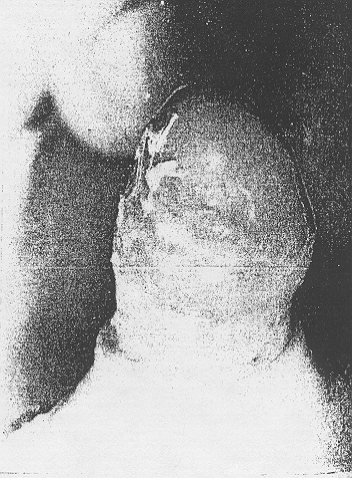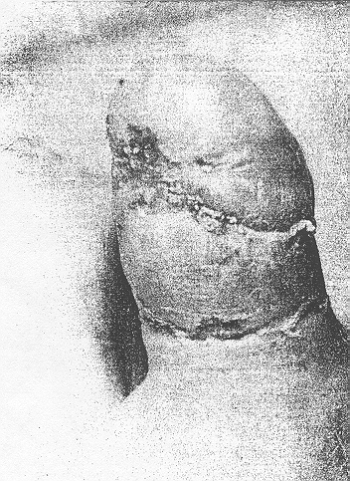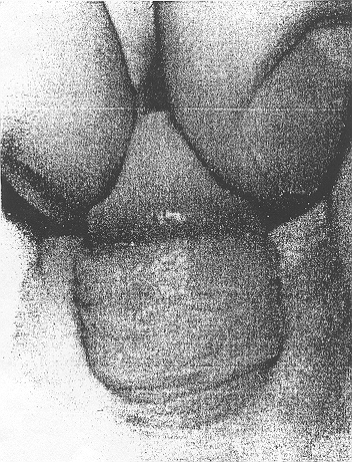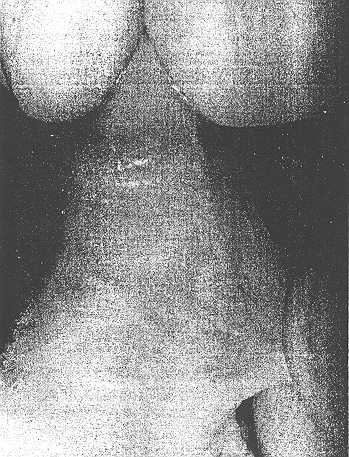
Journal of the Medical Association of Georgia, Volume 51: Pages 394-396, August 1962.
A case is reported in which a cylindrical area of excess skin nearly a centimeter in length was inadvertently removed from the shaft of the penis.
REPORTS OF MAJOR LOSSES OF PENILE SKIN as a complication of circumcision are fairly common; the causes of such loss being usually either a complicating infection,1,2 the use of the electrocautery,3,4 or improper surgical technic.5,6 Minor degrees of excessive skin loss appear to have attracted less attention in the literature,7 but we believe that they are also important for two reasons. One, is that considering the many circumcisions performed daily in this country by relatively inexperienced operators, these minor losses are perhaps, after all, quite common.
The other is that when these defects are allowed to heal without grafting, there may be “discomfort” during adulthood,8 and a shortening of the future erectile length of the organ. Theoretically, even a minor inadequacy of penile skin in the shaft would tend to result in a holding back of the subcutaneous part of the penis against theabdominal wall.
An actual, if extreme, example of such a situation is found in a case reported by Byars in which so much excess skin was removed at circumcision that contraction of the remaining skin almost completely “concealed” the penis.5 The subcutaneous part of the shaft was so crowded back against the fatty mons pubis that no organ projected. The opening in the contracted skin at the end of he penis barely permitted the passage of urine.
We have recently followed a case in which a minor excess of skin loss occurred during the routine circumcision of a newborn. We believe that although the length of the cylindrical skin loss in this case averaged less than a centimeter, replacement by a split skin graft was indicated. This decision and its carrying out resulted in a penis which is now normal in appearance and in which we anticipate a fully normal adult length and function.
B. K. A., white male, the result of a full term pregnancy, was born on 11/15/60. Birth weight was six pounds, ten and one quarter ounces. There was no difficulty with resuscitation of the child, and after delivery he was in good condition in the nursery. Physical examination revealed no abnormalities.

On the third day of life, 11/27/60, a circumcision was performed using a Gomco clamp and the infant returned to his bed with the result supposedly satisfactory. The next morning, however, the wound was found pulled apart, and it was apparent that an excess of penile skin had been inadvertently removed. Measurement of the cylindrical defect showed a gap of 1.0 cm. inferiorly and 0.7 cm. superiorly. (see Fig. 1). On 11/28/60, the infant was transferred to the plastic surgical service and intermittent warm saline packs started.

Operation: On 11/30/60 under light general anesthesia, a split graft was cut from the left lower abdomen at 0.009 of an inch and wrapped around the defect in the penis. No sutures were used. The graft was covered with fine mesh gauze (Owen’s rayon) and supported bya few turns of a narrow Gelocast bandage (Duke Laboratories, Inc.). Postoperatively, an effort was made to keep the infant on his side to avoid softening of the dressing with urine, and the hands and feet restrained.
On the fourth postoperative day (12/4/60), all dressings were removed and left off, but restraints were continued for three more days. On the same day (12/4/60), the patient was discharged from the hospital.
Follow-Up: On 2/15/61, two and one-half months postoperatively, the patient was seen in the outpatient department. There was no complaints from the mother. The graft was found to be normally loose and to have blended nicely with the surrounding skin. There was no evidence of constricting scar tissue at the junction lines. (see Figs. 3 and 4).

Eleven months post operatively a second follow-up visit was made, and the same satisfactory situation was found to exist. The mother was reminded that she should return with the child if any evidence of constricting bands should appear as the organ grew larger.
While scrotal flaps are occasionally preferred for resurfacing the denuded penis, and especially where the injury involves the corpora cavernosa,3,9,10,11 and in one case an abdominal flap;12 the treatment of choice generally is considered to be by means of a split graft for adult at about 0.018 of an inch.1,4,13,14,15,16,17 Such a graft, when placed on Buck’s fascia, contracts very little and appears to blend in rapidly with the surrounding skin.
Davis and Berner explain the success of split grafts on the penis as due to two factors: the frequent stretching of the grafts and the fact that the bed is loose fascia and not thick granulation tissue.15
In the case of our infant the graft was cut at 0.009 of an inch and taken from the left lower quandrant of the abdomen. In this area the skin is hairless and the donor site can be closed by suture if desirable.

Although the eleven month follow up in our case revealed no evidence of tightness in the suture lines of the graft, it is still possible that as the penis increases in size such a complication might occur. If and when this should happen, the constricting bands could be dealt with by multiple Z-plasties, much in the manner of the treatment of congenital bands of the extremities.18
A case of routine circumcision in a newborn is reported in which a cylindrical area of excess skin measuring nearly a centimeter in length was inadvertently removed from the shaft of the penis. The defect was splitgrafted two days later with an apparently excellent result.
We believe that these minor excesses of skin loss following circucision must be more common than indicated by the literature, and that many of them should be split grafted to avoid the possibility of a future scarred and/or shortened penile shaft.
102 Doctors Building
The Circumcision Information and Resource Pages are a not-for-profit educational resource and library. IntactiWiki hosts this website but is not responsible for the content of this site. CIRP makes documents available without charge, for informational purposes only. The contents of this site are not intended to replace the professional medical or legal advice of a licensed practitioner.
© CIRP.org 1996-2024 | Please visit our sponsor and host: IntactiWiki.